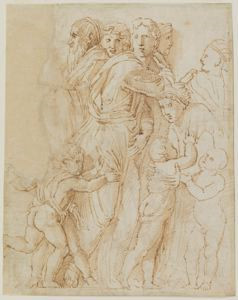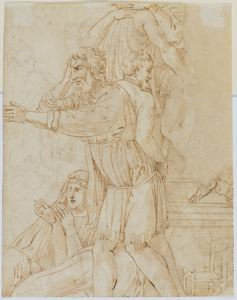Copy from Donatello's "Miracle of the Miser's Heart"
Artist: Raphael (School of, after Donatello) (Italian, 1483-1520)
Medium: pen and brown ink on laid paper
Dimensions: 10 1/16 in. x 8 in. (25.56 cm. x 20.32 cm.)
Credit Line: Bequest of the Honorable James Bowdoin III
Accession Number: 1811.6.a.&.b
- anchor in circle, six-pointed star above
Type: watermark
Location:
Materials: - "Polidor Caravaggio" (now removed)
Type: inscription
Location: bottom
Materials: graphite
- James Bowdoin III( Collector, Boston) - 1811.
- Bowdoin College Museum of Art( Museum, Brunswick, Maine) 1811- . Bequest
- Old Master Drawings at Bowdoin College
- Bowdoin College Museum of Art. ( 5/17/1985 - 7/7/1985)
- Clark Art Institute. ( 9/14/1985 - 10/27/1985)
- University of Kansas. ( 1/19/1986 - 3/2/1986)
- Art Gallery of Ontario. ( 5/17/1986 - 6/29/1986)
- Prints/Drawings & Drawings/Prints, 1500-1800
- Bowdoin College Museum of Art. ( 8/4/2009 - 9/20/2009)
- Lovers and Saints: Art of the Italian Renaissance
- Goodyear, Frank. ( 1/24/2014 - 1/4/2015)
Type: catalogue Author: H. Johnson Document Title: Catalogue of the Bowdoin College art Collections Publ. Place: Brunswick, Maine Reference: no. 7 Remarks: (as Polidore [sic] da Caravaggio after Donatello) Publisher: Bowdoin College Section Title: Pt. I, The Bowdoin Drawings Date: 1885 Type: catalogue Author: Bowdoin College Museum of Art Document Title: Bowdoin Museum of Fine Arts, Walker Art Building Edition: 4th Publ. Place: Brunswick, Maine Reference: no. 7 Remarks: (as Polidore [sic] da Caravaggio after Donatello) Publisher: Bowdoin College Section Title: Descriptive Catalogue of the . . . Date: 1930 Type: exhibition catalogue Author: David P. Becker Document Title: Old Master Drawings at Bowdoin College Publ. Place: Brunswick, Maine Location: pp. 68-71 Reference: no. 31 Publisher: Bowdoin College Date: 1985
This drawing is intriguing for the study of Raphael's artistic sources. It once bore an old ascription to Polidoro da Caravaggio (1490/1500-1543?), which was likely trimmed in the late nineteenth century. It was recognized as a copy after Donatello, although the subject was misidentified as the Fall of Troy (Johnson 1885, no. 7). The original source is a relief from the high altar of the Basilica of Saint Anthony in Padua, completed by Donatello between 1447 and 1450. The altar consists of nearly thirty different elements, both free-standing bronze sculptures and reliefs. The current arrangement (fig. 1) is a reconstruction as the altar was disassembled in the sixteenth century. The Bowdoin drawing depicts figures from a scene in the life of St. Anthony, when the saint, after giving a sermon on the sin of greed, insists that the chest cavity of a recently deceased wealthy man be opened, revealing that is empty (fig. 2). His heart is discovered in a box with his gold, confirming that “for where your treasure is, there will your heart be also” (Luke 12:34).
In 1969, Michael Jaffé suggested that this sheet is closer to the manner of Pirro Ligorio (1513/14-1583) than to that of Polidoro and identified a related drawing after the same set of reliefs (Jaffé, pl. 134). Konrad Oberhuber recognized the Bowdoin drawing as a copy from the Donatello reliefs and associated it within the immediate circle of Raphael, as a copy perhaps of a lost drawing by the master rather than of the reliefs themselves. At that time, he attributed the Bowdoin drawing to Giulio Romano (1499-1546). He then suggested that Giovanni Francesco Penni (died ca. 1528), another of Raphael's assistants, was a more likely possibility. The precise attribution of drawings from Raphael's studio, particularly just before and after his death, is the subject of much scholarly debate (Gere and Turner, 230).
There are no known autograph Raphael drawings that are direct copies of Donatello sculptures, and the nearest parallel from his hand is in Munich (fig. 3). It depicts the entombment of a bishop and the composition closely parallels Donatello’s relief (Joannides, 180). Raphael unquestionably incorporated elements from Donatello in his own compositions in several other instances. Among these, the central three figures on the recto of the Bowdoin drawing appear virtually unchanged on the steps on the right edge of Raphael's School of Athens fresco of 1509-1511 in the Stanza della Segnatura in the Vatican (fig. 4), and the figure of the fleeing woman appears in the Massacre of the Innocents, later engraved by Marcantonio Raimondi (fig. 5).
At least three other drawn copies of this particular relief exist from the school of Raphael, in the Uffizi, the Albertina, and the Biblioteca Reale in Turin; and the same figures portrayed in the Bowdoin sheet appear in all. The Uffizi and Turin studies, both of which had traditionally been given to Raphael himself, are quite rapid, loosely delineated sketches. One side of the Albertina sheet (fig. 6), which Alfred Stix and L. Frolich-Bum attributed perhaps to Penni (the sheet has an old inscription to him) and is now given to Biagio Pupini (ca. 1490-1575), has been very fully developed into solid relief and considerable chiaroscuro (Stix and Frolich-Bum, cat. no. 124). The reverse of that sheet is loosely sketched after the original relief (fig. 7).
In the Bowdoin study, the plasticity of the relief is carefully developed, particularly for the central figures of the recto, and the pen work seems more deliberate. This quality leads to the conclusion that the Bowdoin drawing can be placed within Raphael's studio. Comparison of the several drawn studies with the relief reveals small variations in the attitudes of the figures, with the Bowdoin version seeming the more restrained, in keeping with the original relief and with Raphael's final use of the group in the School of Athens. Erwin Mitsch has noted that in the Albertina copy, the kneeling woman with the two children is twisted into greater sculptural depth than in the relief (Mitsch, cat. no. 77) An original study after Donatello by Raphael would be datable before 1509. If the Bowdoin drawing was done by either Giulio or Penni from the original by Raphael, this copy would be dated after their arrival in the studio around 1515.
David P. Becker (edited by Sarah Cantor)
References:
Gere, John, and Nicholas Turner. Drawings by Raphael. London: The British Museum, 1983.
Jaffé, Michael. Rubens and Italy. Oxford: Phaidon Press, 1977.
Joannides, Paul. The Drawings of Raphael: with a complete catalogue. Berkeley: University of California Press, 1983.
Johnson, Henry. Catalogue of the Bowdoin College Art Collections Part I: The Bowdoin Drawings. Brunswick, ME: Bowdoin College, 1885.
Mitsch, Erwin. Raphael in der Albertina: aus Anlass des 500. Vienna: Österreichischer Bundesverlag, 1983.
Stix, Alfred and L. Frohlich-Bum. Beschreibender Katalog der Handzeichnungen in der Staatlichen Graphischen Sammlung Albertina. Band 3, Die Zeichnungen der Toskanischen umbrischen und Römischen Schulen. Vienna: Anton Schroll, 1932.
Images:
Fig. 1: Donatello, High Altar of the Basilica of St. Anthony in Padua (reconstruction), 1447-50 http://www.wga.hu/html_m/d/donatell/2_mature/padova/1altar1.html
Fig. 2: Donatello Miracle of the Miser’s Heart, 1447-50, bronze, Basilica of St. Anthony, Padua http://www.wga.hu/html_m/d/donatell/2_mature/padova/2altar13.html
Fig. 3: Raphael Funeral of a Bishop, ca. 1507, pen and brown ink, Graphische Sammlung, Munich, 2457
Fig. 4: Raphael School of Athens, 1509-11, fresco, Stanza della Segnatura, Vatican https://en.wikipedia.org/wiki/The_School_of_Athens#/media/File:Sanzio_01.jpg
Fig. 5: Marcantonio Raimondi after Raphael Massacre of the Innocents, 1512-14, engraving, Metropolitan Museum of Art, New York, 22.67.21 http://www.metmuseum.org/collection/the-collection-online/search/342748
Fig. 6: Attributed to Biagio Pupini Copy after Donatello’s Miracle of the Miser’s Heart (recto), early 16th century, pen and brown wash, heightened with white on prepared paper, Graphische Sammlung, Albertina, Vienna, 304 http://sammlungenonline.albertina.at/default.aspx?lng=german2#35b87578-7aa5-4723-9daa-b7383888aa2c
Fig. 7: Attributed to Biagio Pupini Copy after Donatello’s Miracle of the Miser’s Heart (verso), early sixteenth century, pen and brown ink, Graphische Sammlung, Albertina, Vienna, 304 http://sammlungenonline.albertina.at/default.aspx?lng=german2#4fbeba88-da7b-4084-9655-b6385c11c76bCommentary credited to David P. Becker (or not otherwise captioned) appeared in his catalogue Old Master Drawings at Bowdoin College (Brunswick: Bowdoin College Museum of Art, 1985).


 Museum of Art
Museum of Art
